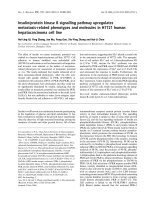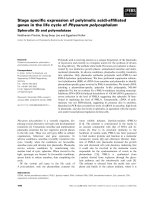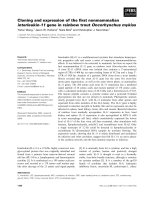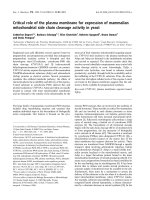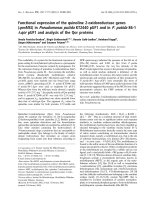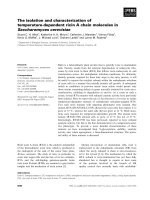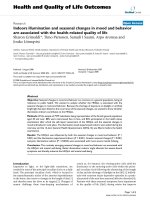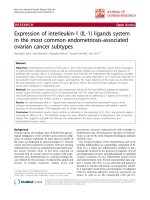Expression of chosen carcinoembryonic related cell adhesion molecules in pancreatic intraepithelial neoplasia (PanIN) associated with chronic pancreatitis and pancreatic ductal
Bạn đang xem bản rút gọn của tài liệu. Xem và tải ngay bản đầy đủ của tài liệu tại đây (2.46 MB, 10 trang )
Int. J. Med. Sci. 2019, Vol. 16
Ivyspring
International Publisher
583
International Journal of Medical Sciences
2019; 16(4): 583-592. doi: 10.7150/ijms.32751
Research Paper
Expression of Chosen Carcinoembryonic-Related Cell
Adhesion Molecules in Pancreatic Intraepithelial
Neoplasia (PanIN) Associated with Chronic Pancreatitis
and Pancreatic Ductal Adenocarcinoma (PDAC)
Justyna Zińczuk1, Konrad Zaręba2, Wioletta Romaniuk3, Dorota Kamińska4, Marcin Nizioł5, Magdalena
Baszun5, Bogusław Kędra2, Katarzyna Guzińska-Ustymowicz5, Anna Pryczynicz5
1.
2.
3.
4.
5.
Department of Clinical Laboratory Diagnostics, Medical University of Bialystok, Waszyngtona 15 St., 15-269 Białystok, Poland
2nd Clinical Department of General and Gastroenterological Surgery, Medical University of Bialystok, M. Skłodowskiej-Curie 24A St., 15-276 Białystok,
Poland
Department of Haematology, Medical University of Bialystok, M. Skłodowskiej-Curie 24A St., 15-276 Białystok, Poland
Department of Laboratory Diagnostics, Independent Public Health Care Unit of the Provincial Hospital Jędrzej Śniadecki in Bialystok, Poland
Department of General Pathomorphology, Medical University of Bialystok, Waszyngtona 13 St., 15-269 Białystok, Poland
Corresponding author: Justyna Zińczuk, Department of Clinical Laboratory Diagnostics, Medical University of Bialystok, Email: , Tel (fax):
+48 (85) 8 31 87 16
© Ivyspring International Publisher. This is an open access article distributed under the terms of the Creative Commons Attribution (CC BY-NC) license
( See for full terms and conditions.
Received: 2019.01.02; Accepted: 2019.03.23; Published: 2019.04.25
Abstract
Aims: Carcinoembryonic antigen-related cell adhesion molecules (CEACAMs) are members of the
glycosylphosphatidylinositol (GPI)-linked immunoglobulin (Ig) superfamily and take part in regulation
of cell adhesion, tumor suppression and angiogenesis. Overexpression of CEACAM 1, 5 and 6 is
widely described in several gastrointestinal epithelial tumors. The aim of study was to evaluate the
expression of CEACAM 1, CEACAM 5 and CEACAM 6 in the most common precursor lesions of
pancreatic ductal adenocarcinoma –pancreatic intraepithelial neoplasia (PanIN).
Methods and results: The study group consisted of 32 patients treated for chronic pancreatitis
and 38 patients with pancreatic ductal adenocarcinoma who also had pancreatic intraepithelial
neoplasia. The expression of CEACAM was performed by immunohistochemical method and
evaluated using 3-point scale: 0 - lack of positive reaction in pancreatic intraepithelial neoplasia, 1
(weak and moderate) - reaction present in 1-30% epithelial cells in PanIN and 2 (strong) - reaction
present in >30% epithelial cells in PanIN. Expression of CEACAM 1, 5 and 6 increased with
increasing degree of advancement of PanIN. Differences in expression of CEACAM 1, 5 and 6
between normal pancreatic ducts and different degrees of PanIN were statistically significant
(p<0.001). We observed relationship between CEACAM1 expression and localization of PanIN in
different parts of the pancreas.
Conclusions: CEACAM 1, CEACAM 5 and CEACAM 6 expression appears to be an early event in
pancreatic carcinogenesis. Moreover, expression of CEACAM 1, 5 and 6 may represent a useful
biomarker that may aid in the identification of precancerous lesions in the pancreas.
Key words: pancreatic intraepithelial neoplasia, PanIN, CEACAM, adhesion molecules
Introduction
Pancreatic cancer is currently the third leading
cause of cancer-related death in the United States and
a major cause of morbidity and mortality worldwide.
According to the American Cancer Society, the
morbidity of pancreatic cancer will equal around
55440 and the mortality, about 44330 in 2018 year in
the USA [1]. Such a high mortality is due to the late
diagnosis and cancer resistance to chemotherapy and
Int. J. Med. Sci. 2019, Vol. 16
radiation [2]. Therefore, it is very important to detect
cancer early, before it changes into an invasive form,
when the possibility of complete cure is minimal.
The most common histological type of pancreatic
cancer (over 95% of cases) is pancreatic ductal
adenocarcinoma (PDAC) which develops from
pancreatic ductal epithelial cells[3]. Studies suggest
that PDAC develops from precursor lesions –
pancreatic intraepithelial neoplasias (PanINs),
intraductal papillary mucinous neoplasms (IPMNs)
and mucinous cystic neoplasms (MCNs). The most
frequently occurring and the best defined in the
literature precursor lesion is pancreatic intraepithelial
neoplasia defined as microscopic flat or papillary and
noninvasive epithelial lesion developing in small
pancreatic ducts (<5mm diameter). These lesions are
composed of cuboidal or columnar cells with varying
amounts of mucin facilitating their distinction from
normal ductal epithelium composed of cuboidal or
low columnar cells with amphophilic cytoplasm and
without any evidence of mucinous cytoplasm [4].
According to the degree of architectural and
cytological atypia in pancreatic ducts, PanINs are
categorized into four grades: the lowest grade - PanIN
1A and PanIN 1B, PanIN 2 – intermediate grade
PanINs and high grade PanIN - PanIN 3. PanIN 3 is
the highest grade, also referred to as carcinoma in situ
[5].
Carcinoembryonic antigen-related cell adhesion
molecules (CEACAMs) belong to the glycosylphosphatidylinositol(GPI)-linked immunoglobulin (Ig)
superfamily and are present on the apical surface of
numerous cell types such as endothelial and epithelial
cells of different organs [6]. According to the cell type
and CEACAM subtype they may have different
functions. Carcinoembryonic antigen-related cell
adhesion molecules participate in the regulation of
cell adhesion and cell cycle, in intracellular and
intercellular signaling, cancer progression, inflammation, angiogenesis, and metastasis [7]. Recent studies
revealed that some of CEACAM molecules, especially
CEACAM 1, 5 and 6 are valid clinical biomarkers and
promising therapeutic targets in melanoma, colorectal, pancreatic and lung cancers [8-11].
CEACAM 1 (CD66a) has the widest tissue
distribution of all members of CEACAM family. It is
present on membrane either at the apical or lateral
poles on different epithelial cells, endothelial cells, as
well as in monocytes, granulocytes, activated T and B
cells and a subset of natural killer cells [12].
Localization of this protein on cell membranes allows
the connection to other surface receptors, extracellular
matrix proteins, integrins and cytoskeletal elements
[7]. Moreover, CEACAM 1 through the ability to
respond to the activation of receptor Tyr kinases
584
(RTKs) may take part in the regulation of downstream
signaling pathways and consequently may indirectly
influence on cancer progression by stimulation of
cellular proliferation, migration, invasion and
metastasis, apoptosis, inflammation, immune evasion,
angiogenesis induction, and genome instability [7,
13].
CEACAM 5 (CD66e) and CEACAM 6 (CD66c)
similarly to CEACAM 1 are involved in homotypic
interactions with other molecules belonging to CEA
family and in heterotypic binding with integrin
receptor [14, 15]. Overexpression of CEACAM 5 and 6
inhibits anoikis which is an apoptotic response in
normal cells to inadequate or inappropriate
intercellular or matrix attachment [16]. In normal
tissue, anoikis prevents ectopic cellular proliferation
whereas tumor cells are characterized by resistance to
anoikis [17]. It suggests that these intercellular
adhesion molecules are involved in primary
tumorigenesis and metastasis in cancers. Moreover,
CEACAM 6 suppression by specific siRNA causes
increased susceptibility to caspase-mediated anoikis,
decreasing of Akt phosphorylation, and inhibits
metastatic abilities [18]. CEACAM 5 is widely
expressed in different types of normal tissues in the
apical membranes of gland cells of the duodenum,
parotid and submaxillary gland, colon, and stomach
and is a tumor marker for several gastrointestinal and
respiratory cancers [19]. Overexpression of CEACAM
6 has been observed in many human cancers such as
colorectal, breast, pancreatic, mucinous ovarian,
gastric, and lung cancers [20]. It was also present in
precancerous lesions of colorectal cancer (colonic
hyperplastic polyps and early adenomas) and was
considered being the earliest molecular change
observed in these lesions.
To date, role of CEACAM 1, 5 and 6 in
development of precancerous lesions in the pancreas
has not been explained. Therefore the aim of this
study was to assess the expression of carcinoembryonic antigen-related cell adhesion molecules 1,
5 and 6, and to investigate their potential role in the
development of pancreatic intraepithelial neoplasia.
Material and methods
Patients
The study group consisted of 32 patients treated
for chronic pancreatitis and 38 patients with
pancreatic ductal adenocarcinoma operated in the 2nd
Clinical Department of General and Gastroenterological Surgery at the University Hospital in
Bialystok, in the years 2006-2014. The characteristics
of the study group are shown in Table 1. The study
was performed in conformity with the Declaration of
Int. J. Med. Sci. 2019, Vol. 16
585
Helsinki for Human Experimentation and received
approval by the Local Bioethics Committee of the
Medical University of Bialystok (nr R-I-002/399/
2016).
Table 1. Characteristics of the study group.
Clinicopathological features
Sex
Male
Female
Age
<60 years
≥60 years
Diagnosis
pancreatitis
pancreatic ductal adenocarcinoma
Location
head
body
tail
body and tail
Frequency, n (%)
35 (50%)
35 (50%)
33 (47.2%)
37 (52.8%)
32 (32.9%)
38 (54.3%)
33 (47.1%)
5 (7.1%)
20 (28.6%)
12 (17.2%)
Histopathological examination and
identification of ductal lesions
The postoperative material was fixed in buffered
formalin and paraffin-embedded. From paraffin
blocks, 5-μm sections were cut and stained with
hematoxylin-eosin (H+E). Histopathological analysis
included diagnosis of primary disease, but also the
presence and stage of pancreatic intraepithelial
neoplasia which has been described in each patient.
All slides were reviewed by two independent
pathologists. PanIN lesions were classified according
to the guidelines established by international group of
pathologists on Pancreas Cancer Think Tank meeting
sponsored by the National Cancer Institute and held
in Park City, Utah in September 16-19, 1999 [21].
Briefly, PanIN 1A is an epithelial flat lesion whereas
PanIN 1B is a papillary or micropapillary lesion
composed of tall columnar cells with basally located
nuclei and abundant supranuclear mucin without
cytologic atypia. PanIN 2 is a mucinous, epithelial flat
or papillary lesion with some nuclear abnormalities
including loss of polarity, crowding, enlargement,
nuclear stratification and hyperchromatism. PanIN 3
usually is papillary or micropapillary architecture
with abnormal cribriforming, budding and luminal
necrosis with cytologic abnormalities, such as loss of
nuclear polarity, dystrophic goblet cells, atypical
mitotic figures and macronucleoli [21]. The presence
of PanINs was evaluated on the slides of the normal
pancreatic tissue at least 5 mm away from the
carcinoma, while, in the non-neoplastic lesions,
PanINs were evaluated in the site of an ongoing
disease process.
Immunohistochemistry
Tissue blocks were cut using a microtome into
4-μm-thick sections on silanized glasses. The sections
were deparaffinized in xylenes and hydrated in
alcohols. In order to exhibit an antigen, the tissue
sections were heated in a water bath at 99°C for 20
min and next cooled for 20 min in room temperature
in citrate buffer (pH=6.0). Then, they were incubated
with 3% hydrogen peroxide to block endogenous
peroxidase and, next, with protein block (Novocastra)
for 5 min. Incubation with CEACAM 1 mouse
anti-human polyclonal antibody (clone VU-3C6, R&D
Systems) at a dilution of 1:100, CEACAM 5 mouse
anti-human polyclonal antibody (clone 5B12, Sigma
Aldrich) at a dilution of 1:100 and CEACAM 6 mouse
anti-human polyclonal antibody (R&D Systems) at a
dilution of 1:100 for 60 minutes in room temperature.
Following streptavidin-biotin reaction (biotinylated
secondary antibody, streptavidin-HRP; Novocastra),
the antigen antibody complex was visualized by
application of chromogen 3,3′-diaminobenzidine
(DAB, Novocastra). All slides were stained simultaneously with appropriate specimens, which served as
positive controls. We used as a positive control cervical cancerous tissue for CEACAM1, colon cancerous
tissue for CEACAM5 and colon and breast cancerous
tissue were used as positive control for CEACAM6.
Negative controls were performed by incubating the
sample without the primary antibodies.
Analysis of Immunohistochemical data
Immunohistochemical assessment of CEACAM
1, 5 and 6 was performed in all pancreatic ducts in
specimen from each patient. In the case of more than
one type of PanIN lesions present in many ducts in
each patient the authors described a mean value of
expression of protein. Reaction was independently
assessed by two senior pathologists who have been
blinded to the clinicopathological data. In case of
disagreement, the scoring was discussed by the
pathologists until they agreed on a final result.
Positive expression of CEACAM 1 and 5 was assessed
in membrane of pancreatic ductal epithelial cells
along the luminal cell border. In case of CEACAM 6
positive reaction also was assessed along the luminal
cell border and in the cytoplasm of pancreatic ductal
epithelial cells. The results of the staining were
semiquantitatively assessed for the percentage of the
positively stained cells. Expression of CEACAM 1, 5
and 6 was evaluated based on 3-point scale: 0 – lack of
expression or weak positive reaction in less than 5% of
cells, 1 (weak and moderate) – focal, positive reaction
present in 5-25% of pancreatic ductal epithelial cells
and 2 (strong) – diffuse, positive reaction present in
>25% of pancreatic ductal epithelial cells.
Int. J. Med. Sci. 2019, Vol. 16
586
Statistical analysis
Statistical analyses were performed using
STATISTICA 10.0 (Statsoft, Cracow, Poland) and
GraphPad Prism 7. The correlations of CEACAM
proteins
expression
with
clinicopathological
parameters, and the significance of differences in
CEACAM expression were determined by Pearson’s
chi-square test. All statistics were two-tailed with p
value ≤ 0.05 considered significant. Missing data were
removed in pairs.
Results
The evaluation of pancreatic intraepithelial
neoplasia in patients with pancreatic ductal
adenocarcinoma and pancreatitis
In patients with pancreatic ductal adenocarcinoma the most common lesions was PanIN 1 (55.4%)
like as in group with pancreatitis (55.0%). PanIN 2 in
group with PDAC constituted 22.3% and PanIN 3 –
11.5% of all founded lesions. Similar results were
obtained in patients with pancreatitis in case of PanIN
2 which constituted 20.2%. PanIN 3 occurred less
frequently in patients with pancreatitis than in group
with PDAC and constituted 5.5% of all lesions (Table
2).
Analysis of CEACAM 1, 5 and 6 expression in
relations to clinicopathological parameters
The positive immunohistochemical reaction of
CEACAM 1 and 5 was observed in membrane of
pancreatic ductal epithelial cells along the luminal cell
border. In case of CEACAM 6 positive reaction also
was present along the luminal cell border and in the
cytoplasm of pancreatic ductal epithelial cells (Figure
1, 2, 3). In normal pancreatic ducts staining for
CEACAM 1, 5 and 6 was negative.
Table 2. PanIN assessed in the group of patients with pancreatitis and PDAC.
Pancreatitis
Pancreatic ductal adenocarcinoma
Total number of lesions
Normal pancreatic ducts (%)
PanIN 1a (%)
PanIN 1b (%) PanIN 1 (1a + 1b) (%) PanIN 2 (%)
PanIN 3 (%)
21 (19.3%)
14 (10.8%)
35 (14.7%)
30 (27.5%)
35 (26.9%)
65 (27.2%)
30 (27.5%)
37 (28.5%)
67 (28.0%)
6 (5.5%)
15 (11.5%)
21 (8.8%)
60 (55.0%)
72 (55.4%)
132 (55.2%)
22 (20.2%)
29 (22.3%)
51 (21.3%)
Figure 1. Immunoreactivity of CEACAM1 in PanIN 1A (1a), in PanIN 1B (1b), in PanIN 2 (1c), in PanIN 3 (1d). Magnification 200x
Int. J. Med. Sci. 2019, Vol. 16
587
Figure 2. Immunoreactivity of CEACAM5 in PanIN 1A (2a), in PanIN 1B (2b), in PanIN 2 (2c), in PanIN 3 (2d). Magnification 200x.
Figure 3. Immunoreactivity of CEACAM6 in PanIN 1A (3a), in PanIN 1B (3b), in PanIN 2 (3c), in PanIN 3 (3d) Magnification 200x.
Int. J. Med. Sci. 2019, Vol. 16
The associations of CEACAM 1, 5 and 6
expression with clinicopathological parameters has
been shown in Table 3. Statistical analysis revealed
associations between membrane (p=0.041) and
cytoplasm (p=0.012) CEACAM 6 expression with
gender. Membrane and cytoplasmic CEACAM 6
expression was higher among females than in males.
The percentage of PanIN lesions with membrane
expression of CEACAM 6 assessed as a strong was
2.5% in males and 10.5% in females. Similar results
have been received in case of cytoplasmic reaction percentage of PanIN lesions with strong expression
was 6.3% in males and 18.8% in females. The strong
expression of CEACAM 5 was associated with
location of PanIN lesions in the pancreas (p=0.006).
Most lesions with strong expression localized in the
head of pancreas in comparison to other parts.
Moreover, expression of CEACAM 5 and CEACAM 6
(both membrane and cytoplasmic) was stronger
(p=0.012,
p=0.010,
p<0.001)
in
pancreatic
intraepithelial neoplasia coexisted with pancreatic
ductal adenocarcinoma than in the case of chronic
pancreatitis. Pancreatic intraepithelial neoplasia
lesions with moderate and strong expression of
CEACAM 5 in PDAC constituted 11.3% and 17.6% of
all founded lesions whereas in pancreatitis reached
4.6% and 8.4% of all lesions. In case of pancreatitis,
percentage of PanIN lesions without positive staining
for CEACAM 5 was higher compared to PanIN in
588
PDAC (25.5% vs. 32.6%). Similar results were
observed for cytoplasmic expression of CEACAM 6.
Percentage of lesions with moderate and strong
expression were higher in PDAC (19.7% and 19.2%) in
comparison with pancreatitis (17.6% and 7.2%).
However, a group of PanIN without positive
cytoplasmic reaction for CEACAM 6 was more
numerous in chronic pancreatitis (20.1%) than in
PDAC (15.5%) (Table 3).
Comparison of CEACAM 1, 5 and 6 expression
between normal pancreatic ducts and different
degrees of pancreatic intraepithelial neoplasia
The expression of CEACAM1, 5 and 6 was
significantly more frequent in pancreatic intraepithelial neoplasia in comparison with normal pancreatic
ducts. The expression of these proteins was higher in
pancreatic intraepithelial neoplasia compared to the
normal tissue (p<0.0001). Immunohistochemical
reaction of CEACAM 1, 5 and 6 was higher in PanIN
1, PanIN 2 and PanIN 3 in comparison with normal
pancreatic ducts (p<0.0001). The expression of
CEACAM 1, 5 and 6 occured more frequently in
PanIN 2 and PanIN 3 in comparison with PanIN 1
(p<0.0001). The expression of CEACAM 1, 5 and 6
was also higher in PanIN 3 compared to PanIN 2
lesions (Figure 4).
Correlations between CEACAM 1, 5 and 6
expressions
The Pearson chi-square test revealed
positive correlations between the expressions of
CEACAM 1, 5 and 6 (p<0.001) in pancreatic
intraepithelial neoplasia. This relationship was
directly proportional, which means that if the
patient had a positive expression of e.g.
CEACAM 1 he would also have a positive
expression of CEACAM 5 and 6.
Discussion
Figure 4. Comparison of the CEACAM1 (A), CEACAM5 (B) and CEACAM6 (C, D)
expression in various degrees of PanIN.
Pancreatic cancer is the most lethal cancer
because in most cases it is diagnosed at advanced
stage, when radical pancreatic resection is
impossible. About 95% of pancreatic cancers
constitutes pancreatic ductal adenocarcinoma
developed in the exocrine pancreas. It was
discovered that PDAC can transform in stepwise
progression from precursor lesions referred as
pancreatic intraepithelial neoplasia. Pancreatic
intraepithelial neoplasia has shown the same
spectrum of genetic abnormalities as PDAC, e.g.
KRAS mutation, loss CDKN2A function and
genetic inactivation of TP53, SMAD4, and BRCA2
[22]. Further investigation of pancreatic
intraepithelial neoplasia development may help
to detect pancreatic cancer earlier.
Int. J. Med. Sci. 2019, Vol. 16
589
Table 3. Associations of CEACAM1, 5 and 6 expression with chosen clinicopathological parameters.
CEACAM are cell adhesion molecules that
participate in generating and maintaining normal
tissue architecture and cellular polarity, but they also
play an important role in invasion and progression of
cancer. Malignant tumors and precancerous lesions
are characterized by disruption of tissue architecture
and abnormal differentiation. The process of cell
differentiation is associated with the loss of cell-cell
binding and alterations in the expression of cell
adhesion molecules. These are also features of the
invasive potential of malignant tumors. Jinka et al.
[23] indicated that changes in cell–cell and cell–matrix
interactions may be responsible for the ability of
cancer cells to cross tissue boundaries and to spread to
distant sites [23]. In our work we assessed the
expression of CEACAM1, 5 and 6 in pancreatic
intraepithelial neoplasia in a group of patients with
chronic pancreatitis and pancreatic ductal adenocarcinoma.
One of the molecules responsible for the maintenance of normal tissue architecture is CEACAM1
which N-terminal immunoglobulin domain mediates
cell-cell adhesion. CEACAM1 may acts on the cell
surface as a sensor molecule to regulate cellular
signaling. Moreover, CEACAM1 is a substrate of the
insulin receptor and its activation by tyrosine kinase
of the insulin receptor after insulin binding begins a
cascade of signaling pathways to induce cell growth
and proliferation. In addition to the control of cellular
proliferation, CEACAM1 may regulate apoptosis,
promotes angiogenesis and cellular metastasis,
mediates bacterial adhesion and internalization as a
pathogen receptor, and even adjusts immune
response [24]. So far, function of CEACAM1 in
precancerous lesions of pancreas has not been
established, although there are several studies
assessing
immunohistochemical
and
serum
expression of chosen CEACAM molecules in course of
different cancers e.g. in colon, breast and lung cancer
[8, 9, 11, 18, 25]. In our immunohistochemical analysis
we found a positive expression of CEACAM1 in
majority of pancreatic intraepithelial neoplasia
lesions. Expression of CEACAM1 was positive both in
the group of patients with chronic pancreatitis and
Int. J. Med. Sci. 2019, Vol. 16
pancreatic ductal adenocarcinoma without any
statistically significant differences between both
groups. We observed statistically significant increase
in CEACAM1 expression in different degrees of
pancreatic intraepithelial neoplasia. It may be
associated with transformation of epithelial cells from
normal cuboidal cells of epithelium to higher degree
of pancreatic intraepithelial neoplasia – PanIN 3.
Similar results have been showed by Simeone et al.
[25]. They observed positive expression of CEACAM1
in 9% cases of PanIN 1A, 22% cases of PanIN 2 and
85% cases of PanIN 3. Moreover, Simeone et al. [25]
evaluated CEACAM1 levels in sera patients with
pancreatic ductal adenocarcinoma and compared
obtained results with group of healthy people. They
showed significantly higher level of CEACAM1 in
patients with pancreatic ductal adenocarcinoma and
concluded that CEACAM1 may be a novel biomarker
for pancreatic cancer. Additionally, their results of
positive CEACAM1 expression in precancerous
lesions - in pancreatic intraepithelial neoplasia - may
support the possibility that CEACAM1 may be used
in identifying patients with early stage disease [25].
On the other hand, Simonetti et al. [26] examined the
expression of CEACAM1 in normal tissue, dysplastic
lesions, oral squamous cell carcinoma and carcinoma
in situ. They observed positive expression in normal
tissue, while it was negative in dysplastic lesions.
These authors suggest that CEACAM1 expression
changes dynamically and is reduced in early stages of
many cancers [26]. Some authors described decreased
expression of CEACAM1 in colon, endometrium,
breast and prostate cancers and suggested that this
molecule may act as a tumor suppressor and
maintains the normal phenotype of epithelial cells [7].
On the other hand, other authors observed the
overexpression of CEACAM1 in melanoma, oral and
lung cancers and showed an association between the
expression of this protein with poor prognosis.
Moreover, they concluded that overexpression of
CEACAM1 in these cancers may be a marker for
progression and metastasis [10, 27, 28]. These
observations support a hypothesis that expression of
CEACAM1 depends on the type of cancer and is
associated with prognosis [29].
CEACAM5, similarly as CEACAM1, takes part
in homophilic and heterophilic (CEA binding to
non-CEA molecules) interactions indicating a role of
this molecule in intercellular adhesion which is
involved in cancer invasion and metastasis [15].
Moreover, CEACAM5 acts as a chemoattractant and
may promote the metastatic potential in some
experimental tumors. Supression of CEACAM5
expression decreases metastases formation in mouse
experimental models, whereas anti-CEACAM5 intact
590
mAb, MN-14, also delayed cellular death due to
metastasis in a human colorectal cancer model [14].
Overexpression of CEACAM5 occurs in about 90% of
gastrointestinal, colorectal and pancreatic cancers,
70% of non-small cell lung cancers and 50% of breast
cancers [19]. Expression of CEACAM5 has been
extensively studied in various cancers and in gastric
non-neoplastic and neoplastic lesions but no in the
precancerous lesions of the pancreas. In our work we
assessed the expression of CEACAM5 in pancreatic
intraepithelial neoplasia and we observed that the
expression of this protein increased with increasing
degree of PanIN and was absent in normal pancreatic
ducts. CEACAM5 expression was significantly higher
in PanIN coexisted with pancreatic ductal
adenocarcinoma than in pancreatitis. Additionally,
we showed that CEACAM5 expression was
associated with presence of CEACAM6 expression.
Similar results have been observed by Gebauer et al.
[8] but they evaluated expression of CEACAM1, 5 and
6 in pancreatic ductal adenocarcinoma. They revealed
an association between CEACAM5 and 6 expression
as well as between CEACAM5 and positive lymph
node status and distant metastasis. Additionally, the
Kaplan-Meier survival analysis performed by
Gebauer et al. [8] showed that elevated CEACAM5
and/or 6 expression in patients with PDAC was
connected with shortened overall survival and
disease free survival. As regards to Gebauer’s [8] and
our results we may conclude that overexpression of
CEACAM5 present in different degrees of pancreatic
intraepithelial neoplasia may be an unfavorable
prognostic factor [8]. Blumenthal et al. [15] evaluated
CEACAM5 expression in colon, ovary, breast, lung,
prostate and pancreatic cancers. In their work,
independently from type of tumor cell differentiation,
CEACAM5 expression was higher in pancreatic
ductal adenocarcinoma than in non-neoplastic
pancreas. Similarly, in our study, CEACAM5
expression was absent in normal pancreatic ducts and
increased with increasing degree of PanIN which is
precursor lesion of pancreatic ductal adenocarcinoma.
We also assessed the expression of CEACAM6 in
pancreatic intraepithelial neoplasia and we observed
simultaneously cytoplasmic and membrane reaction
in PanIN. A statistically significant increase in the
cytoplasmic and membrane expression of CEACAM6
following the increasing stage of pancreatic
intraepithelial neoplasia was showed in our study.
Additionally, cytoplasmic expression was stronger
than membrane. We also observed a statistically
significant relationship between cytoplasmic and
membrane level of CEACAM6 with disease, since the
expression of CEACAM6 was stronger in patients
with pancreatic ductal adenocarcinoma than in
Int. J. Med. Sci. 2019, Vol. 16
pancreatitis. Many authors confirmed that CEACAM6
expression is positive not only in cancer but also in
inflammatory tissue. It may be caused by
pro-inflammatory properties of CEACAM [8].
Moreover, CEACAM6 may inhibit cell differentiation
and cell polarization, and it also causes disruption of
tissue architecture. Overexpression of CEACAM6
modulates tumor progression in terms of cell invasion
and metastasis, and represents an acquired advantage
of tumor cells directly responsible for an invasive
phenotype [30]. Overexpression of CEACAM5 and
CEACAM6 in pancreatic ductal adenocarcinoma is
associated with greater resistance to anoikis and
increased
metastatic
ability.
However,
posttranscriptional inhibition of CEACAM5 and
CEACAM6 expression reduce the potential of
pancreatic adenocarcinoma cells to resist anoikis and
liver metastasizing. Resistance to anoikis is a property
of transformed cells and a determinant of
tumorigenesis and metastasis [31]. Duxbury et al. [32]
also assessed CEACAM6 expression in pancreatic
intraepithelial neoplasia and observed that 66% of
PanIN 1A had no CEACAM6 expression. In their
results 65% of PanIN 1B demonstrated weak
CEACAM6 staining. Simultaneously, the prevalence
of CEACAM6 expression was similar among PanIN 2
and PanIN 1B lesions, however, the staining was more
intense among PanIN 2. All of the PanIN 3 lesions
expressed CEACAM6 at moderate to high levels.
Similarly as in our paper, increased expression of
CEACAM6 following the increasing degree of
pancreatic intraepithelial neoplasia was statistically
significant. Duxbury et al. [18] concluded that
CEACAM6 is not only a potentially useful biomarker,
but may participate in oncogenic changes that occur
during progression from PanIN lesions to invasive
pancreatic cancer. In other study regarding
assessment of CEACAM6 expression in pancreatic
cancer, Duxbury et al. [18, 31, 32] showed that
overexpression of CEACAM6 increases cellular
invasiveness but posttranscriptional silencing of
CEACAM6 expression decreases the invasiveness of
pancreatic adenocarcinoma cells. In our paper
CEACAM6 expression increases with increasing of
stage of pancreatic intraepithelial neoplasia. Thus we
suppose that this molecule is associated with
transformation of pancreatic ductal epithelial cells in
pancreatic intraepithelial neoplasia and may promote
a transformation of benign lesions into an aggressive
invasive carcinoma.
In summary, positive expression of CEACAM1,
5 and 6 appears to be an early event in progression
from normal pancreatic ductal epithelium to
pancreatic intraepithelial neoplasia. It is supposed
that CEACAM molecules may play an important role
591
in the transformation of epithelial cells. Furthermore,
these molecules may become in future a potential
marker that will help in the identification of
precancerous lesions in the pancreas.
Competing Interests
The authors have declared that no competing
interest exists.
References
1.
2.
3.
4.
5.
6.
7.
8.
9.
10.
11.
12.
13.
14.
15.
16.
17.
18.
19.
20.
21.
22.
23.
24.
25.
26.
Society AC. Cancer facts & figures 2017. Atlanta, American Cancer Society,
2017.
Garrido-Laguna I, Hidalgo M. Pancreatic cancer: From state-of-the-art
treatments to promising novel therapies. Nat Rev Clin Oncol 2015;12:319-34.
Hidalgo M, Cascinu S, Kleeff J, et al. Addressing the challenges of pancreatic
cancer: Future directions for improving outcomes. Pancreatology
2015;15:8-18.
Haugk B. Pancreatic intraepithelial neoplasia-can we detect early pancreatic
cancer? Histopathology 2010;57:503-14.
Hruban RH, Adsay NV, Albores-Saavedra J, et al. Pancreatic intraepithelial
neoplasia: A new nomenclature and classification system for pancreatic duct
lesions. Am J Surg Pathol 2001;25:579-86.
Kuespert K, Pils S, Hauck CR. Ceacams: Their role in physiology and
pathophysiology. Curr Opin Cell Biol 2006;18:565-71.
Beauchemin N, Arabzadeh A. Carcinoembryonic antigen-related cell
adhesion molecules (ceacams) in cancer progression and metastasis. Cancer
Metastasis Rev 2013;32:643-71.
Gebauer F, Wicklein D, Horst J, et al. Carcinoembryonic antigen-related cell
adhesion molecules (ceacam) 1, 5 and 6 as biomarkers in pancreatic cancer.
PLoS One 2014;9:e113023.
Thöm I, Schult-Kronefeld O, Burkholder I, et al. Expression of ceacam-1 in
pulmonary adenocarcinomas and their metastases. Anticancer Res
2009;29:249-54.
Thies A, Moll I, Berger J, et al. Ceacam1 expression in cutaneous malignant
melanoma predicts the development of metastatic disease. J Clin Oncol
2002;20:2530-6.
Dango S, Sienel W, Schreiber M, et al. Elevated expression of
carcinoembryonic antigen-related cell adhesion molecule 1 (ceacam-1) is
associated with increased angiogenic potential in non-small-cell lung cancer.
Lung Cancer 2008;60:426-33.
Prall F, Nollau P, Neumaier M, et al. Cd66a (bgp), an adhesion molecule of
the carcinoembryonic antigen family, is expressed in epithelium,
endothelium, and myeloid cells in a wide range of normal human tissues. J
Histochem Cytochem 1996;44:35-41.
Hanahan D, Weinberg RA. Hallmarks of cancer: The next generation. Cell
2011;144:646-74.
Blumenthal RD, Hansen HJ, Goldenberg DM. Inhibition of adhesion,
invasion, and metastasis by antibodies targeting ceacam6 (nca-90) and
ceacam5 (carcinoembryonic antigen). Cancer Res 2005;65:8809-17.
Blumenthal RD, Leon E, Hansen HJ, et al. Expression patterns of ceacam5
and ceacam6 in primary and metastatic cancers. BMC Cancer 2007;7:2.
Ordoñez C, Screaton RA, Ilantzis C, et al. Human carcinoembryonic antigen
functions as a general inhibitor of anoikis. Cancer Res 2000;60:3419-24.
Shanmugathasan M, Jothy S. Apoptosis, anoikis and their relevance to the
pathobiology of colon cancer. Pathol Int 2000;50:273-9.
Duxbury MS, Matros E, Clancy T, et al. Ceacam6 is a novel biomarker in
pancreatic adenocarcinoma and panin lesions. Ann Surg 2005;241:491-6.
Zhou J, Fan X, Chen N, et al. Identification of ceacam5 as a biomarker for
prewarning and prognosis in gastric cancer. J Histochem Cytochem
2015;63:922-30.
Kim KS, Kim JT, Lee SJ, et al. Overexpression and clinical significance of
carcinoembryonic antigen-related cell adhesion molecule 6 in colorectal
cancer. Clin Chim Acta 2013;415:12-9.
Kern S, Hruban R, Hollingsworth MA, et al. A white paper: The product of a
pancreas cancer think tank. Cancer Res 2001;61:4923-32.
He XY, Yuan YZ: Advances in pancreatic cancer research: Moving towards
early detection. World J Gastroenterol 2014;20:11241-8.
Jinka R, Kapoor R, Sistla PG, et al. Alterations in cell-extracellular matrix
interactions during progression of cancers. Int J Cell Biol 2012;2012:219196.
Ling Y, Wang J, Wang L, et al. Roles of ceacam1 in cell communication and
signaling of lung cancer and other diseases. Cancer Metastasis Rev
2015;34:347-57.
Simeone DM, Ji B, Banerjee M, et al. Ceacam1, a novel serum biomarker for
pancreatic cancer. Pancreas 2007;34:436-43.
Simonetti O, Lucarini G, Rubini C, et al. Correlation between
immunohistochemical staining of ceacam1 and clinicopathological findings
in oral pre-neoplastic lesions and squamous cell carcinoma. Med Mol
Morphol 2018;51:41-7.
Int. J. Med. Sci. 2019, Vol. 16
27.
28.
29.
30.
31.
32.
592
Zhou CJ, Qu X, Yang YM, et al. Ceacam1 distribution and it's effects on
angiogenesis and lymphangiogenesis in oral carcinoma. Oral Oncol
2009;45:883-6.
Laack E, Nikbakht H, Peters A, et al. Expression of ceacam1 in
adenocarcinoma of the lung: A factor of independent prognostic significance.
J Clin Oncol 2002;20:4279-84.
Fiori V, Magnani M, Cianfriglia M. The expression and modulation of
ceacam1 and tumor cell transformation. Ann Ist Super Sanita 2012;48:161-71.
Rizeq B, Zakaria Z, Ouhtit A. Towards understanding the mechanisms of
actions of carcinoembryonic antigen-related cell adhesion molecule 6 in
cancer progression. Cancer Sci 2018;109:33-42.
Duxbury MS, Ito H, Benoit E, et al. Ceacam6 is a determinant of pancreatic
adenocarcinoma cellular invasiveness. Br J Cancer 2004;91:1384-90.
Duxbury MS, Ito H, Zinner MJ, et al. Ceacam6 gene silencing impairs anoikis
resistance and in vivo metastatic ability of pancreatic adenocarcinoma cells.
Oncogene 2004;23:465-73.
